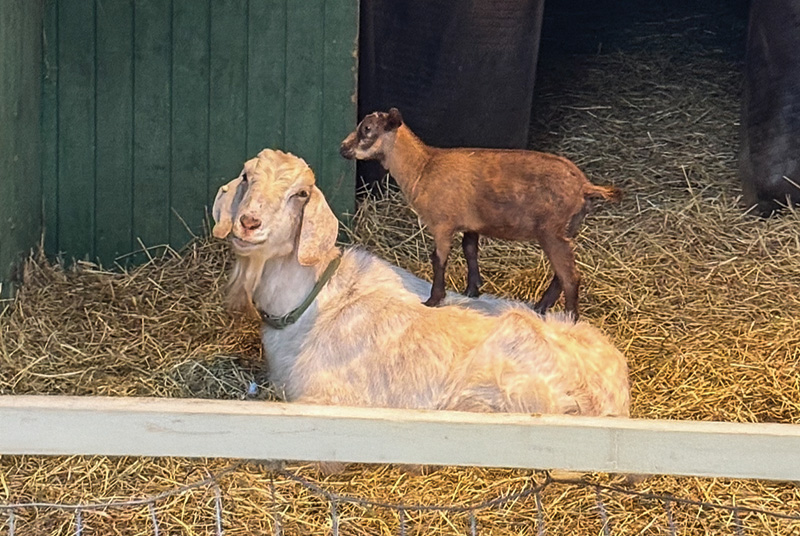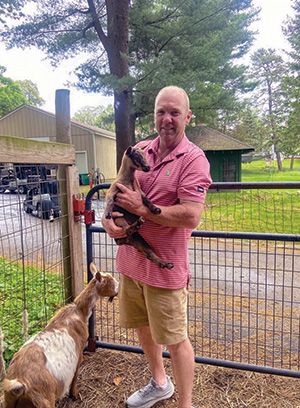
Two of Needham (Mass.) Golf Club superintendent Tim Hood's voracious crew members Photos courtesy of Tim Hood
Tim Hood isn’t the first golf course superintendent to employ goats to help tame hard-to-manage out-of-play areas at his facility. Not by a long shot.
But after a couple of years of renting the ravenous ungulates, Hood decided it was time to step up his goat game.
In 2019, Hood took full-time possession of three goats to help manage the grounds along Needham Golf Club in Needham, Mass.
“We rented goats for a few years. They’d come out with four goats, but it was very costly, like $400 a week,” says Hood, Needham GC’s GCSAA Class A superintendent/goatherd/beekeeper and 27-year association member. “We just couldn’t manage something like that financially. I have a friend, someone who worked with me, who is a superintendent not too far away. He has seven goats. He’s a big animal lover and jumped into that goat thing. He rented them for a little bit, and now he has seven or eight goats that he bought. He says it’s easy, that they’re simple animals to manage. It’s amazing what they can do when they start grazing, especially when you have seven of them.”
Goats are naturals at munching their way through hard-to-control vegetation, especially the woody-stemmed underbrush and poison ivy that’s so prevalent around the outskirts of the nine-hole Needham GC, which lies about 10 miles southwest of downtown Boston. That’s why, back in 2016, Wood started paying the Goatscaping Co. — “Eastern Massachusetts’ source for green clearing and invasives management” — to shepherd, er, goatherd, four goats around the course. The company provided solar-powered, low-voltage fencing to keep the critters contained, plus a small shelter for inclement weather.
“They don’t like to be out in the rain,” Hood says.
After a few days of grazing, they’d be moved.
“Mostly just on the borders, areas we’d not really do much,” Hood says. “When balls did go in there, we’d be, ‘That’s too bad. We don’t go in there.’ We’d draw a line and say, ‘This is how much we manage.’ But there were areas we wouldn’t mind seeing cleared out. And there were some conservation areas where you’d need permitting if you wanted to go in there and clean them out. For grazing, it’s not a factor.
“You could tell right away when they were clearing the area. After they were done, you could see the opening. People could go in there and find their balls, and we didn’t have to do any kind of brush cutting or herbicide applications.”
Hood with two of the goats, Gimme (being held) and Sandy.

Hood was so impressed after just a couple of years of renting, he decided to buy. As luck would have it, Goatscaping was looking to downsize and gave Hood three older Nubian goats — Birdie, Bogie and Brady (named in honor of another G.O.A.T., Tom Brady; after all, this is New England Patriots territory) — in 2019.
The three acclimated quickly and happily munched away, much to the enjoyment of Needham GC’s golfers and the local community.
“A big plus of it was the people’s reaction,” Hood says. “We’re in a pretty populated suburb of Boston. There are no farmlands in the area. People are out there golfing, and all of a sudden they’ll see three goats in the tree line. It’s a nice look. It’s a good feeling seeing that in nature. It’s soothing.”
Birdie and Brady died this year — “Basically, old age,” Hood says — and Bogie wallowed in loneliness, so Hood picked up a mother-daughter pair of Nigerian dwarf goats, Sandy and Gimme, to get the goat band back together.
“When we were down to one, people were concerned we’d stop the program,” Hood says. “But we figured it was working well for us. It hasn’t stopped us from other applications we have to do, but we’re trying to do our best to use other means of maintaining that brush area.
“And we’ve done a lot of things in the community, like Goat Days, when people come out with their kids. We have flyers with fun facts about goats. We have private membership, but we lease the land from town. It’s town-owned land, and in the wintertime, we allow people to come out to sled and cross-country ski. One of the biggest attractions is to come see the goats. It’s like a little petting zoo.”
The course is leaning into its identity of being something of a goat track. A recently built beverage-and-snack shack at the turn has been emblazoned with a sign naming it the Goat Shack.
“They’re trying to say it’s the Greatest of All Turns,” Hood says with a laugh. “Now the pressure’s on to keep it going. As a whole organization, everyone is pleased. It has worked out really well.”
Andrew Hartsock is GCM’s editor-in-chief.